
|
Ron Lord was one of Australia's best goalkeeper ever and the first Olympic-goalie for his country back in Melbourne 1956. This is his private diary, written on a day by day basis. It describes how the team went about its training and the way they played on tour, the Ron Lord Olympic games diary .....
"By all means use my Olympic diary on your
website-as long as you think you can get something worthwhile from it. I would have liked
to have made it more comprehensive at the time, but you realise that each days events were
written at the end of each day when I was very tired and so the day's comments were rather
brief."
Ron Lord
Honours:
Australian International 1951-64
NSW Representative 1950-64
Playing Record: Drummoyne
(1949), Auburn (1950-57), Sydney Prague (1957-65)
Australia's Olympic
Soccer Squad for the Melbourne games 1956:
Goalkeepers: Ron Lord (Auburn NSW), Bill Henderson (Granville NSW)
Defenders: Bob Bignell (Captain) (Corrimal NSW), John Pettigrew
(Cessnock NSW), Al Warren (Blackstone Queensland), Con Purser (North Perth WA), Bill
Harbourn (Hakoah Victoria).
Midfielders: Cliff Sander (St.Helens Queensland), Bob Wemyss (Polonia
Victoria), George Arthur (Wallsend NSW), Al Rattray (Caledonians Tasmania).
Forwards: Bruce Morrow (Wallsend NSW), Peter Stone (Bankstown NSW), Ted
Smith (Moreland Victoria), Graeme McMillan (Y.M.C.A. Queensland), Alec Beattie (Budapest
SA), Jack Lennard (Cessnock NSW), Col Kitching (St.Helens Queensland), Frank Laughran
(Moreland Victoria), Brian Vogler (Dunmore Queensland).
Coach: Len Young (Victoria),
Trainer: Bill Lyon (Victoria), Manager and Deputy Commissioner of
Police in NSW: George Smith, Assistant Manager: Roy Druery (NSW)
Some details about the Olympic
Village
The Village itself is at the north west corner of a large housing estate, the
development of which was commenced in 1950. The site of the Village is about eight miles
north east of the centre of the city of Melbourne, which is the capital of the state of
Victoria. In all, a total of 4,500 homes will be erected in this area, thus making it the
largest housing scheme in the state.
The district in which the Olympic Village is situated is known as West Heidelberg.
The first steps toward design and creation of the Olympic Village was taken in 1953
when the West Heidelberg site was finally selected. The first house in the village was
begun in September 1954. By September 1956, almost all-building construction had been
completed.
The erection of kitchens, dining halls and other facilities for Olympic visitors
has been so-ordinated by the Housing Commission, so that these units combine with the
homes to present a pleasing contemporary pattern of form and colour.
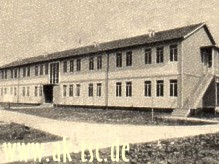 During the Olympic Games in Melbourne, more than
6,000 athletes and officials from over 70 countries will live here in new houses and
apartment buildings.
During the Olympic Games in Melbourne, more than
6,000 athletes and officials from over 70 countries will live here in new houses and
apartment buildings.
After the games, our own citizens will occupy all the homes
in the Village. Permanent buildings will replace the relatively few temporary structures.
Not only has the Commission been responsible for the erection of 841 dwellings of many
types in the Village, but it has also provided for a permanent Community Hall, Post
Office, shops, trading areas and other facilities to be used first by the Olympic
athletes, and later by our citizens.
The Olympic Games will be officially declared open at the
Opening Day ceremony on Thursday November 22 1956. Competitive events will
begin the following day. To prepare ourselves for what lies ahead we have arrived 18 days
early, as have some of the other nations.
Day 1, Monday 5th November 1956
We took off from Mascot at 12.45p.m. and arrived at Essendon
Airport Melbourne 3.30p.m. On the way from the Terminal to the Olympic Village, in
Heidelberg Bruce Morrow's bag was lost from the back of the taxi.
The village entrance was set back off the main road about 80 or so yards. Either side of the drive up to the entrance was flagpoles carrying the flags of the competing nations. In the centre of the drive was a manned guard-house. We found out later you had to show an identification pass to get in or out of the Village, athlete or not.
Our bus stopped by the guardhouse and
we waited in the bus, George Smith our manager went into the Administration Office to find
out where we would be billeted.
We had to cool our heels for a couple of hours in a nearby house while our
arrangements were sorted out. Eventually we settled into a 2 story block of
flats about 1 kilometre into and almost at the end of the Village. Our address is 86 Flack
Street, Heidelberg.
We were bunking two to a room. Billy
Henderson and myself were together on the top floor. The room is quite adequate, the beds
are comfortable and we have two large windows in the back wall making the room light and
airy.
News Flash - Word has come through that Bruce Morrow's bag has been found - he's
got a smile a mile wide.
George Smith and Roy Druery the co-manager are in the room
next to us. We had tea at the Olympic canteen in the Village. There was plenty of food. I
had tomato soup, roast lamb (a hard decision lamb or pork chops) baked potatoes, mashed
potato, cauliflower and pumpkin. Jam Sponge with ice cream for sweets. Seconds of
everything if you felt inclined. Or if you cared for a cold meal you could walk around the
tables and serve yourself from a avriety of cold meats that included chicken and lobster.
There were many types of side salads also on display.
On
another table there were boxes of fruit; oranges, apples, pears, bananas, etc. We were
told to take whatever we required. There were women waiting to serve you with milk, pure
orange juice, tea, coffee and to take away your plates when you were finished.
After tea George Smith called us all together and our Coach and Trainer were
introduced to us.
Our coach is Len Young an Englishman who coaches in Victoria. Our trainer's name is
Bill Lyon and I believe a professional runner.
We were all issued with an Australian Olympic Tracksuit (one
only). What will we do when its in the wash? It is green and gold obviously and the
general consensus was they were pretty good. Its something that we will all wear with a
great deal of pride.
He then spelt out what he expected of
us and gave details regarding times for meals, training, etc. They are;
At 7.30 a.m. we have to assemble outside our flat and walk (5 mins) up to the Mess
Hall for breakfast. At 9.30 a.m. the bus will pick us up and take us to the ground where
we will train from 10 until 12.
The bus will pick us up at 12 and take us back to the Village for lunch at 12.
At 1.30 p.m. the bus again takes us to the ground and we will train from 2 until 4
p.m. Bus back to the village and tea at 6.30 p.m.
After tea we are free until 10 p.m. and are then expected to be in our quarters.
Seems like a busy day. There's a fresh breeze blowing and it's going to be a cool night.
Day 2, Tuesday 6th November
1956
Sun shining. Breakfast at 7.45 a.m. Porridge, 2 sausages with
bacon, eggs and a few chips, followed by coffee. We trained from 10 until 12 at Campbell
Reserve Moreland about 10 minutes bus ride from the village. Trained again from 2 until 4
p.m. Mostly running today.
We'll probably do fitness training this week. Most of us have not played for 4
weeks or more so were going to have to do some hard conditioning work.
The amount of training that we are doing gives one a healthy
appetite. For tea I had - Oxtail soup, Braised steak and vegetables, followed by ice cream
and pineapple slices and a couple of glasses of orange juice. Most of the squad is
suffering from muscle soreness and tiredness.
It will be early to bed tonight.
Day 3, Wednesday 7th November
1956
Same schedule as yesterday's training AM and PM. We received
our toilet set and a pair of gym shoes tonight. I have just heard a whisper that we might
be going into Melbourne sometime later this week to be measured up for clothing. We are
slowly getting used to our surroundings and information is filtering in.
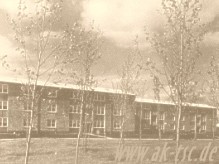 The
women's quarters is within the village and is on the diagonally opposite side of the
Village to where we are. We haven't seen it but we are told it is surrounded by a 7-foot
high wire fence with barbed wire on top. Its off limits to males.
The
women's quarters is within the village and is on the diagonally opposite side of the
Village to where we are. We haven't seen it but we are told it is surrounded by a 7-foot
high wire fence with barbed wire on top. Its off limits to males.
A 7-foot high wire fence surrounds the entire perimeter of the village and has
barbed wire on top. The only way in is by the main gate and there are Army personnel on
duty there to prevent unauthorised people from gaining entry. Athletes have been issued
with an identification pass that includes their photograph and even though we might have
on our Australian tracksuit we still have to flash our pass to get into the village.
We have been told we can bring visitors into the village to show them around and to
have a meal but you must follow the correct procedure.
First, obtain a visitors form from the main gate office. Get it signed by the team
manager and present it to the main gate office and you are then issued with a pass. But I
believe there is a limit on the number of visitors for the one team that can be brought in
on the day. So get in early.
Tonight a few of the boys and myself went to the shops that
are just outside the main gate and we were mobbed by autograph hunters.
The road leading into the village entrance is very impressive. On each side of the
road there are flagpoles carrying the flags of the competing nations. They are a colourful
sight flying in the breeze. There are many spectators milling around just soaking up he
atmosphere hoping to see some of the athletes. It rained this morning but cleared to a
sunny afternoon.
Day 4, Thursday November 8th
1956
It's been a beautiful sunny day. Really too hot for training but train we did, AM
and PM.
Everyone's complaining of calf muscle soreness. Mines so sore that it is painful
walking up steps. I saw Ray Smee and a few of the water polo players at breakfast. I used
to play Water Polo against Ray some years back.
Also saw Dawn Fraser but she didn't see me. I'll catch up with her later. Dawn used
to swim with the Drummoyne Swimming Club at the same time as my brother Ken and myself.
There are eleven large Dining Halls that are located in approximately the centre of the
village. Each one has its own kitchen and caters for the diet of different nations. I
wouldn't like to be the one doing the washing up. We have new neighbours.
 Japan Arrived while we were at training and they
are directly opposite us. They have the rising sun flying from the flagpole and we are
told had a quiet ceremony raising it singing songs and so forth.
Japan Arrived while we were at training and they
are directly opposite us. They have the rising sun flying from the flagpole and we are
told had a quiet ceremony raising it singing songs and so forth.
As one of the boys said "You can't pick your
neighbours." I intend to carry my autograph book with me at every opportunity. In the
evening some of the boys and myself went up to the recreation hall to see a movie.
Day 5, Friday November 9th 1956
I wrote a few quick lines to Kath this morning
and told her Bill and I look like being able to get soccer tickets for three days of the
soccer. Kath is coming down with Margaret Henderson and her two brothers Brian and Lindsey
Hilton for the Japan v Australia game. Although it's been overcast all day, it's been very
hot.
This morning we trained at the Moreland Soccer Club's ground. My thigh and calf
muscles have been very sore but I feel they are starting to loosen off. All the other lads
have had the same complaint. I spoke to Dawn Fraser yesterday. She is taking my autograph
to the women's quarters. I also spoke to John Hendriks whom I know from the Drummoyne
Swimming Club.
After lunch we all bundled into a bus
and went into Melbourne. We were all fitted out with Training Gear, 2 official white dress
shirts, a Panama hat with Olympic band, Tan Brogue shoes and cream trousers. When we get
our Green Olympic blazer it should be a pretty smart outfit. A few days back I mentioned
the women's quarters were surrounded by a high wire fence.
Well, the word is that a hole has been found in the fence - and I don't think it
was put there to let the girls out. There was a special treat for us tonight.
After Tea we all went up to the recreation hall to watch Bob Dyer and his wife
Dolly, broadcast their very popular radio show. It is called The Bob Dyer 'Pick a Box'
show. There was another show immediately afterwards called "It pays to be
funny". On the Bob Dyer show - John Marshall won a camera - Shirley Strickland a
watch - Murray Rose a dozen shirts - and Lorraine Crapp a new Morris Minor motor car. They
were all "Lucky" to pick a box that entitled them to answer any easy question
asked of them. It was a great night!
Day 6, Saturday November 10th
1956
Heavy rain overnight. Intermittent showers throughout the
day.
Today we trained at the Melbourne Showground. We took picnic lunches with us and
trained from 11 a.m. to 1 p.m. and 3 to 5 p.m. Part of our physical training consisted of
piggybacking one another up and down the grandstand steps. I think everyone was aware of
the physical danger from a fall going down. I know I was. Late this afternoon I got the
autographs of the Australian Divers - Bill Tully, Frank Murphy, Rosalyn Barton and Ron
Faulds. Also got the scullers - Mervyn Woods and Staurt MacKenzie.
After tea I caught up on my washing.
Day 7, Sunday November 11th
1956
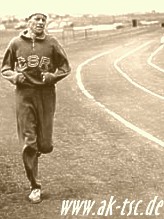 Physically
we had a fairly easy morning. We did exercises and light running on the cinders track. We
were able to watch some of the Athletics competitors working out - among them the great
Czechoslovakian runner Zatopek and his wife Dana, and the Australian runner Dave Stevens.
Physically
we had a fairly easy morning. We did exercises and light running on the cinders track. We
were able to watch some of the Athletics competitors working out - among them the great
Czechoslovakian runner Zatopek and his wife Dana, and the Australian runner Dave Stevens.
I was fortunate to have my book with me and got Zatopek's autograph. In the
afternoon the squad took a bus into Melbourne and we did a tour of the Olympic swimming
pool. We also had a look inside the Melbourne Cricket Ground. It will be the main Olympic
Arena and it looked a picture.
We walked on the Olympic Park Soccer Ground that has not long been completed and on
which the preliminary soccer matches will be played - and finally a tour of the cycling
track and hockey field. All of the venues are very close to one another.
After tea some of the lads and myself went up to the
recreation hall and saw films of the Australian swimming training sessions up in
Townsville and also Jon Hendricks trip to Honolulu. Overcast weather with a cool breeze
today.
Day 8, Monday November 12th
1956
This morning we trained again at Morelands. After a week of
concentrated training I'm sure all of the boy's have improved their speed and stamina. I
know I have.
This is an extract from a letter I wrote to Kath - "Bill and I were told at
training this morning that we can get seven Grandstand soccer tickets for each of the 27th
28th 29th. That will be two tickets for Mr. and Mrs. Henderson for each day, and five for
each day for Margaret, Brian and Lindsay Hilton and yourself.
The only tickets I look like being able to get for Neil are for the Basketball
sometime this week. I'll write to him tonight. The weather so far Kath has been very
changeable, some hot days, some very cold. Every night so far I've had three blankets on.
To be on the safe side it might be wise to bring some warm things with you. The village is
beginning to fill up now. Most of the athletes are very friendly and will mostly always
pass the time of day.
The Japanese always nod and smile and
I've taken a few photographs of them. The Russians are a couple of blocks away from us and
are in a 2 storey apartments that form a quadrangle around a grassed reserve. On the grass
they have set up a wooden stage about 12 feet's square and 2 feet high and they practise
their weightlifting here. They also like to kick a soccer ball around, but then, who
doesn't. Crazy weather! My forehead is peeling because of the sun we had last week, but
the weather is now as cold as charity and the wind is whistling at times.
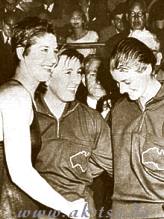 Tomorrow afternoon we are having two players added to the squad to
make up two teams and we are going to have a game.
Tomorrow afternoon we are having two players added to the squad to
make up two teams and we are going to have a game.
I got my autograph book back from Dawn
Fraser at lunch. I've got female swimmers - Lorraine Crapp, Beverly Bainbridge, Faith
Leech, Sandra Morgan and Barbara Evans.
After lunch the squad took the bus into St. Kilda to the hot sea baths. The
bathhouse is in a building on the waterfront and consists of a number of cubicles. Each
contains a large sized family bath, filled with hot seawater and it's great to lie back in
the hot water and relax. It does wonders for relieving sore and tired muscles.
Day 9, Tuesday November 13th
1956
The weather has been overcast most of the day with sunshine
in the late afternoon - rain at 8 p.m. Two local players were added to our squad of 20 and
we played a very welcome game amongst ourselves this morning at Campbell Parade,
Morelands. I say welcome because if nothing else it gave us a change from the mainly
physical conditioning we have been doing.
In the afternoon we trained on the Yarra Bank opposite the
Olympic Swimming Pool.
Word is that tonight at the Recreation Hall there will be an exchange of national
badges by those athletes that are interested in doing so. It was a good night and I made a
couple of exchanges although one was a little embarrassing.
I went up to one guy, a South American
and asked him if he spoke English. He shook his head indicating no. So I held my bronze
kangaroo badge up and proffered it toward him. He said "Silver". Thinking he
meant the badge I said "No it's bronze".
He said again this time indicating himself with his finger "me De Silva".
We exchanged badges with a laugh. It turned out his name was De Silva and he was Brazil's
hop-step and jump representative. I got his autograph and I can't make out the first name.
The Russian basketball team has a player who is 7 foot 4.5
inches tall. He is huge. We saw him come into the hall tonight and it gave us a laugh to
see him duck down to get under the doorjamb. The athletes are very friendly and I'm
finding it all a great experience.
Day 10, Wednesday November 14th
1956
A beautiful day - glorious sunshine. This morning we trained in Melbourne's
beautiful Botanical Gardens running up and down inclines and jumping over seats. Again 2
local players were added to our 20-man squad and in the afternoon we played a game amongst
ourselves at the Melbourne Showground.
I got more autographs this afternoon. They were track athletes - Betty Cuthbert,
Marlene Matthew's, Shirley Strickland and Norma Thrower. All the lads are feeling very
tired.
Day 11,
Thursday November 15th 1956
We trained in the morning out on the Yarra Bank. I had a
quick lunch and got back to my room so that I could write a letter to Kath. I told her
amongst other things that - "We are a tired lot of footballers and that for the first
5 or 6 days going to training on the bus, everybody was full of beans laughing and joking
- but not so much now". I didn't have time to finish the letter so I will do so when
I get back to the village tonight after we have played the Russians.
It is now 1.30 p.m. and the bus driver is tooting his horn.
He is taking us to Melbourne where we will have a fitting for our Olympic blazers. I will
finish this letter when I get back tonight after the game against the Russians.
The Russians took us to the cleaners tonight when they beat us
15 goals to 1 at the Showground.
The score was 7-1 at half-time. They were far too good as the scoreline shows. It
has been overcast all day with rain starting at midday. The game started at 8 p.m. and it
rained throughout the first half. The Russians made it look easy in the wet and greasy
conditions.
It's 12.30 a.m. Friday and as I mentioned earlier I'm back to
finish the letter. This is part of it - "We are not long back after having played the
Russian and you will know by now we have gone down 15 goals to 1. These Russians are
really good.
Nine of them play for the club side 'Sparta' and their control of the ball is a
delight to watch. They'd have to be favourites to win the medal although the Bulgarians
will make them earn it.
The 20 players in our squad all got a run, one half each. I
played the first half and although it might sounds strange to say this after having let 7
in, I was not unhappy with the way I played.
We played too square in defence. The first goal of the seven was from about 16
yards out and I was unsighted, 5 were from the ball being slipped through for their player
to run onto and the last one was a header in the top corner.
There was a crowd of about 2,500 which wasn't too bad considering the night. Its
now 1 a.m. Friday. I'll get this letter in this morning's post and you'll probably get it
on tomorrow's delivery."
Day 12, Friday November 16th
1956
Heavy rain during the night. Showers on and off all day. This
morning we trained at the Moreland club's ground. A light training run for one half hour
or so at the Yarra ground in the early afternoon and then we all went across the road to
the Olympic Swimming Pool. We watched the Australian Divers Tully and Barbara McAuley and
the full squad of our swimmers going through their paces. Dawn Fraser is back in the pool
after a few days with sinus trouble. It's no wonder swimmers eat so much.
They certainly burn up some energy.
More autographs today - Australian swim captain John Devitt.
Swimmers - John Konrads and John Marshall. I caught up on some washing tonight. I posted
two Basketball tickets to Neil Henderson and a letter to Bill Shipley re tickets.
I received a letter from mum and dad and also Kath today.
Its now 11.30 p.m. It's raining and very windy.
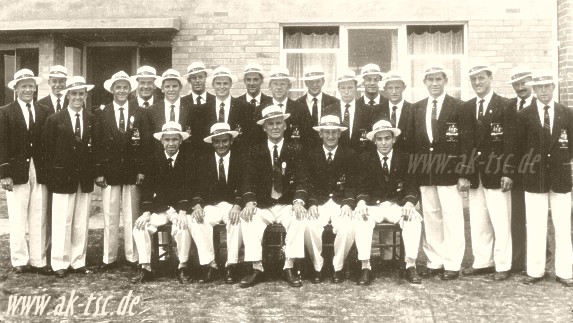
............................see the "Ron Lod Olympic diary" Part 2 on the history page
Copyright ©
2003 THE SOUTHERN CROSS
All rights are reserved. No part of this publication may be reproduced, stored into
a retrieval system or transmitted,
in any form or by any means, electronic, mechanical, photocopying,
recording, or otherwise, without the prior
written permission of the author.
